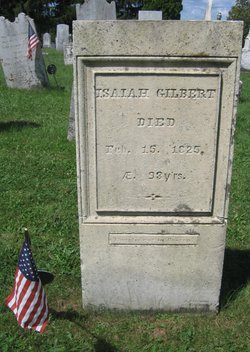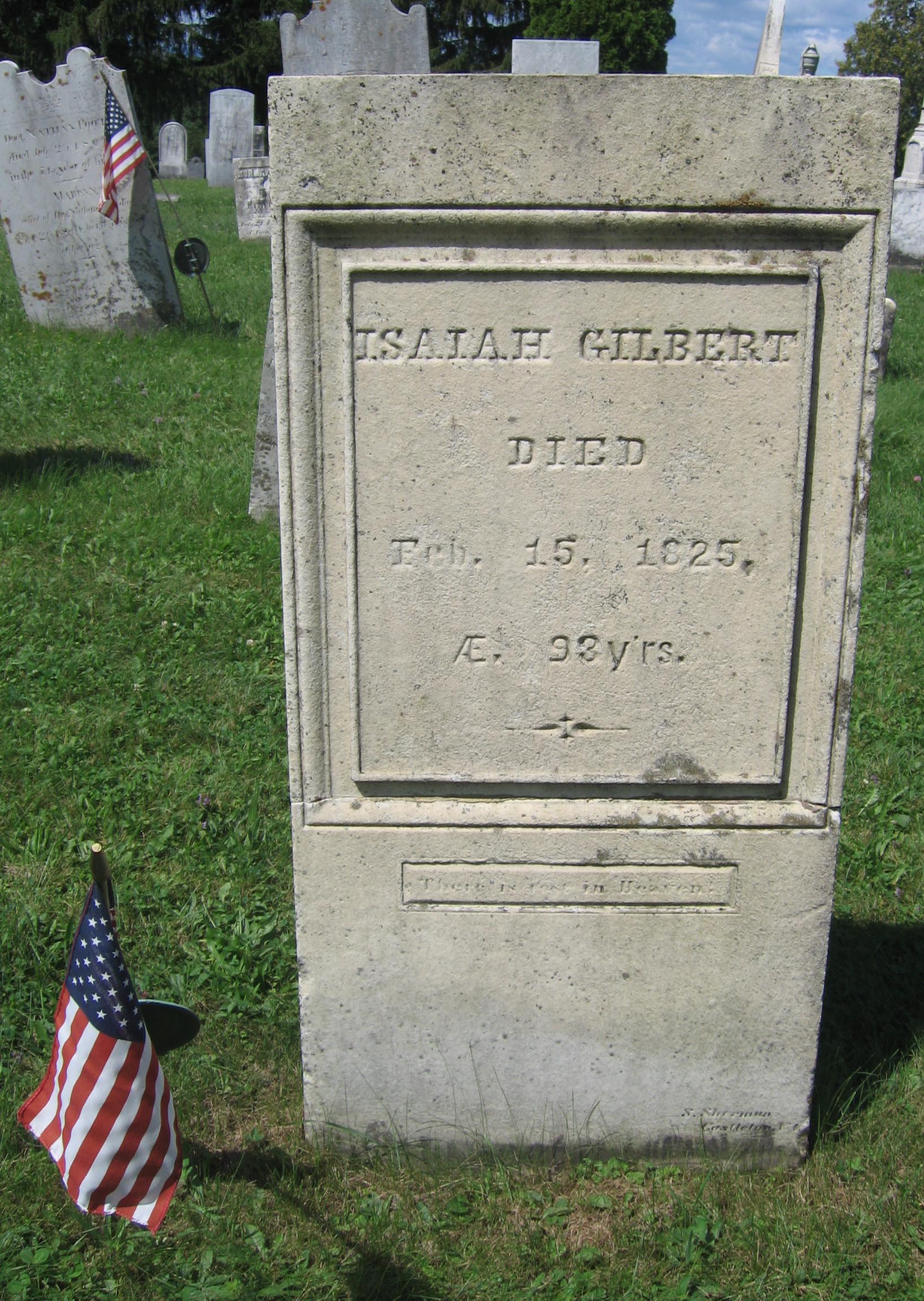Isaiah was born in Hartford, Connecticut in 1733. When he was seventeen years old, his father died, and he chose his older brother, Theodore, as his guardian.
In 1757, at age twenty-four, Isaiah was a member of the British 35th Troop of Foot Soldiers under the command of Lieutenant George Monro stationed at Fort William Henry on the southern shore of Lake George. In August of that year the fort came under siege by the superior forces of French General Montcalm and was forced to surrender. Once disarmed, the British soldiers and the women and children living at the fort were allowed to leave with a guarantee of safe passage from the French; but on their way south the column was attacked by Indians allied to the French who were disgruntled by not receiving the booty they had been promised. Some in the column were killed, some escaped into the wilderness where they hid or died before reaching safety, some were escorted to safety by rescuing French soldiers, and some were taken prisoner by the Indians
and transported to Montreal where they were eventually repatriated through a prisoner exchange. This event was dramatically depicted in James Fenimore Cooper's 1826 historical novel, The Last of the Mohicans and in the 1982 film of the same name. Somehow Isaiah made it back home to Hartford and temporarily ended his military career. A year later he married Esther Bull from the nearby town Farmington, and they took up residence farming in Woodbury, Connecticut.
Isaiah was forty-three years old at the onset of the Revolutionary War. In the spring of 1776, after Washington had succeeded in driving the British from Boston, his jubilant army followed the British down to the city of New York. As it marched through Connecticut, the army no doubt stirred Isaiah's patriotism, his anger, and his outrage at British rule as it did so many others in New England. In any case, Isaiah and his brother-in-law, Thomas Bull, enlisted in the Connecticut militia two months before the Declaration of Independence was signed. A record of his service in the Revolutionary War is found in Cothren's
History of Woodbury, Connecticut. It states: Corporal Isaiah Gilbert, Revolutionary Soldier, Fifth Regiment of Light Horse, May 1776 was named Quarter Master Isaiah Gilbert. This cavalry militia was under the command of Major Elisha Sheldon and was known as Sheldon's Horse Regiment. As the cavalry's quarter master, Isaiah accompanied George Washington's Continental forces as
they retreated from New York through New Jersey in the fall of that year. During this march, Washington came to understand the value of a light cavalry in patrolling the surrounding countryside and gathering of intelligence. He asked the Continental Congress to incorporate this cavalry militia into his army, and in December of 1776, Sheldon's Fifth Light Horse Regiment became the Second Continental Light Dragoons.
By December Isaiah Gilbert's enlistment was up, and he returned home to Connecticut. Though Washington was in dire need of soldiers, one cannot blame Isaiah for leaving. He may have been sick, and with Esther's seventh child due,
he certainly knew how badly he was needed there. Thomas Bull remained with the Second Light Dragoons and was at the surrender of General Burgoyne after the Battle of Saratoga in the summer of 1777. It was America's first victory in its fight for independence.
Isaiah Gilbert married 2nd Experience (Wright) Pond, the widow of Philip Pond, Jr. Isaiah and Experience removed from CT to Augusta, NY -- 50 miles to the west of Fort George. There Experience died in 1801 and church records show that Isaiah was "removed" from membership in the Augusta church in 1803. It seems likely that, after the death of his 2nd wife Isaiah them moved to Vermont. There does not appear to be a Findagrave memorial for Experience (Wright) Pond Gilbert. However, her death is recorded in records of the Augusta 1st congregational church (see image 11 / page 9 of volume 1 at https://www.ancestry.com/imageviewer/collections/61048/images/44861_2421401697_1894-00012?backlabel=ReturnSearchResults&queryId=872cde97edc843f7635edbba7fb707ad&pId=1500903853 )
Contributor: Bob Pond
Isaiah was born in Hartford, Connecticut in 1733. When he was seventeen years old, his father died, and he chose his older brother, Theodore, as his guardian.
In 1757, at age twenty-four, Isaiah was a member of the British 35th Troop of Foot Soldiers under the command of Lieutenant George Monro stationed at Fort William Henry on the southern shore of Lake George. In August of that year the fort came under siege by the superior forces of French General Montcalm and was forced to surrender. Once disarmed, the British soldiers and the women and children living at the fort were allowed to leave with a guarantee of safe passage from the French; but on their way south the column was attacked by Indians allied to the French who were disgruntled by not receiving the booty they had been promised. Some in the column were killed, some escaped into the wilderness where they hid or died before reaching safety, some were escorted to safety by rescuing French soldiers, and some were taken prisoner by the Indians
and transported to Montreal where they were eventually repatriated through a prisoner exchange. This event was dramatically depicted in James Fenimore Cooper's 1826 historical novel, The Last of the Mohicans and in the 1982 film of the same name. Somehow Isaiah made it back home to Hartford and temporarily ended his military career. A year later he married Esther Bull from the nearby town Farmington, and they took up residence farming in Woodbury, Connecticut.
Isaiah was forty-three years old at the onset of the Revolutionary War. In the spring of 1776, after Washington had succeeded in driving the British from Boston, his jubilant army followed the British down to the city of New York. As it marched through Connecticut, the army no doubt stirred Isaiah's patriotism, his anger, and his outrage at British rule as it did so many others in New England. In any case, Isaiah and his brother-in-law, Thomas Bull, enlisted in the Connecticut militia two months before the Declaration of Independence was signed. A record of his service in the Revolutionary War is found in Cothren's
History of Woodbury, Connecticut. It states: Corporal Isaiah Gilbert, Revolutionary Soldier, Fifth Regiment of Light Horse, May 1776 was named Quarter Master Isaiah Gilbert. This cavalry militia was under the command of Major Elisha Sheldon and was known as Sheldon's Horse Regiment. As the cavalry's quarter master, Isaiah accompanied George Washington's Continental forces as
they retreated from New York through New Jersey in the fall of that year. During this march, Washington came to understand the value of a light cavalry in patrolling the surrounding countryside and gathering of intelligence. He asked the Continental Congress to incorporate this cavalry militia into his army, and in December of 1776, Sheldon's Fifth Light Horse Regiment became the Second Continental Light Dragoons.
By December Isaiah Gilbert's enlistment was up, and he returned home to Connecticut. Though Washington was in dire need of soldiers, one cannot blame Isaiah for leaving. He may have been sick, and with Esther's seventh child due,
he certainly knew how badly he was needed there. Thomas Bull remained with the Second Light Dragoons and was at the surrender of General Burgoyne after the Battle of Saratoga in the summer of 1777. It was America's first victory in its fight for independence.
Isaiah Gilbert married 2nd Experience (Wright) Pond, the widow of Philip Pond, Jr. Isaiah and Experience removed from CT to Augusta, NY -- 50 miles to the west of Fort George. There Experience died in 1801 and church records show that Isaiah was "removed" from membership in the Augusta church in 1803. It seems likely that, after the death of his 2nd wife Isaiah them moved to Vermont. There does not appear to be a Findagrave memorial for Experience (Wright) Pond Gilbert. However, her death is recorded in records of the Augusta 1st congregational church (see image 11 / page 9 of volume 1 at https://www.ancestry.com/imageviewer/collections/61048/images/44861_2421401697_1894-00012?backlabel=ReturnSearchResults&queryId=872cde97edc843f7635edbba7fb707ad&pId=1500903853 )
Contributor: Bob Pond
Family Members
Advertisement
Advertisement













